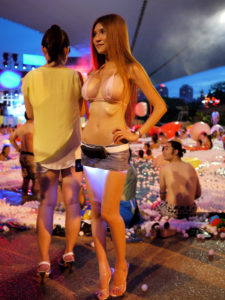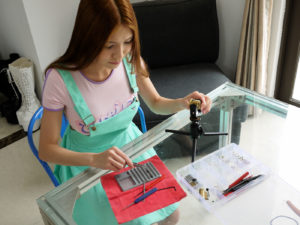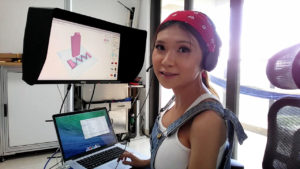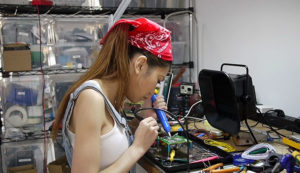 When it comes to the global maker community and the spread of desktop 3D printing among individuals and smaller-scale operations, tech enthusiasts come in all shapes and sizes. One highly popular figure in the online community for makers is China’s Naomi Wu, who has garnered a significant deal of attention as she shares her projects under the moniker SexyCyborg. Naomi’s projects often go hand-in-hand with the image her username might suggest, including one of her earliest using 3D printing, an underlit miniskirt. As she has gained more experience both with the technology at hand and with a position of being a voice in the making community, Naomi has continued on with projects highlighting her viewpoint that appearances can be deceptive. Naomi, an attractive 23-year-old from Shenzhen, has certain enhanced features that may lead some to underestimate — foolishly — the brains that go with her brand of beauty. Running with that concept, Naomi has created projects that enhance the ability to take advantage of that particular area of deception, from some saucy 3D printed shoes that can hide a hacker’s tools of the trade to a 3D printed makeup palette concealing a computer. Her projects largely feature wearable tech geared toward women and are open source, as she encourages sharing and building upon her work.
When it comes to the global maker community and the spread of desktop 3D printing among individuals and smaller-scale operations, tech enthusiasts come in all shapes and sizes. One highly popular figure in the online community for makers is China’s Naomi Wu, who has garnered a significant deal of attention as she shares her projects under the moniker SexyCyborg. Naomi’s projects often go hand-in-hand with the image her username might suggest, including one of her earliest using 3D printing, an underlit miniskirt. As she has gained more experience both with the technology at hand and with a position of being a voice in the making community, Naomi has continued on with projects highlighting her viewpoint that appearances can be deceptive. Naomi, an attractive 23-year-old from Shenzhen, has certain enhanced features that may lead some to underestimate — foolishly — the brains that go with her brand of beauty. Running with that concept, Naomi has created projects that enhance the ability to take advantage of that particular area of deception, from some saucy 3D printed shoes that can hide a hacker’s tools of the trade to a 3D printed makeup palette concealing a computer. Her projects largely feature wearable tech geared toward women and are open source, as she encourages sharing and building upon her work.
Naomi is also a voice for women in 3D printing and an advocate for equality in making, frequently leading an engaged conversation on Twitter as she focuses on seeing more of a broadening of the often white- and male-dominated STEM areas, encouraging young girls and women to participate in tech. She is often supportive of efforts in raising women’s voices and profile in technology, and has encouraged connections for our series spotlighting women’s achievements in 3D printing — and she’s finally consented to her own interview. It’s a pleasure to keep in touch with Naomi, who has an incredible mind and an open heart, and I appreciated the opportunity to more officially talk with her recently to directly share her thoughts on 3D printing, equality, and global technology happenings.
Please fill us in on your background. When did you start to become interested in tech?
“I started off as a coder. I was going to college and needed some extra money for living expenses, I knew some people in the local startup community. They gave me a list of online tutorials to get started with – sites like TeamTreeHouse.com, Codecademy.com and I just started working my way through them. The math was very basic by Chinese standards, stuff we do in middle school, and the rest was just hours and repetition – not something any Chinese student finds at all intimidating. After the GaoKao (our SAT) doing something 100 times or a 1000 times until you get it right is nothing.
I don’t think I have any real aptitude for tech, but I do have determination and good study skills. I was tired of eating the food at the school canteen so I had a lot of motivation. After a few months of this I was able to get some basic entry level work as an online freelancer – what’s called a Junior Developer.
When Maker Faire was in town a few years later I knew that LED wearables and fashion-tech were popular projects, so I went online and followed some video tutorials like I’d already been doing for coding, made a mini-skirt with LEDs underneath. The pictures of it ended up all over and I got a little attention – and who does not like that? So I started making more and getting more into hardware.”
 How did your ‘Sexy Cyborg’ persona develop?
How did your ‘Sexy Cyborg’ persona develop?
“The name was kind of just a spur of the moment thing when I created my Reddit username. People decide because of that my persona is about sex and it’s not really worth arguing with. If it’s sexy to them, then they can enjoy it for that. For me it’s about visibility and gender expression. I was a boyish, homely, shy and geeky teenager who was pretty much invisible. Didn’t like it at all, decided to do something about the first chance I had. Now I look the way I like and no one misses me or has any doubts I’m a girl.
Like my tomboy friends can sometimes be a bit of a cartoon of what they perceive as masculinity, I’m on the same spectrum but the other end – a cartoonish picture of exaggerated female attributes. It makes us happy, no offense is intended and at least in China none taken. In addition, given that it’s very, very hard for Chinese women in tech to be visible this has been useful.
Recently I’ve started a Patreon. It’s the first time I’ve ever made money off of how I look (a least in part) and I’m still trying to get comfortable with that. I think it makes other people more comfortable though – ‘she dresses like that for business’ is a bit more ‘normal’ than ‘she dresses like that because it makes her happy’. But the Patreon funding has let me take Sundays off to do nothing but build, shoot Maker videos and study so that’s been pretty great.”
How does being known as Sexy Cyborg impact your life?
“Not much, I’m just me. My friends find it hilarious because I’m not at all sensual in person.”
 When did you first learn about and start using 3D printing?
When did you first learn about and start using 3D printing?
“Like a lot of women in the 3D printer community I think – my partner at the the time had a 3D printer. After the initial flurry they lost interest in the thing and it gathered dust. I was going to sell it but wanted to see if it was good for anything first. It was an Tiertime Up Plus 2 so very user friendly and I was able to teach myself to use it, I doubt I would have bothered if there had been much difficulty since it did not seem very useful at the time. After the usual keychains and such in the TinkerCAD tutorials I settled down to making boxes as gifts for friends. When I made my first wearable – the underlit skirt with LEDs – I’d already been using a 3D printer for crafts projects so was quite comfortable making a small enclosure.”
How big of a role does 3D printing play in your projects?
“I use 3D printing in almost all of my builds it’s a fast, clean, and simple way to make an attractive and durable enclosure for a project.”
 What can you tell us about the 3D printing scene in China?
What can you tell us about the 3D printing scene in China?
“Three to four years ago the Chinese government was really interested in promoting 3D printing – so there were massive grants available to companies supposedly doing research in this area. For a long time this really hurt innovation because it was more profitable to run a fake ‘3D Printing Research Center’ than it was to actually design, manufacture and sell quality printers. In the last two years or so, much of the funding has been redirected to Makerspaces (causing similar problems) and VR tech. This has caused a lot of the 3D printer companies to have to actually get down to business and figure out how to make good, low cost, reliable printers.
As far as how 3D printing is used domestically here in China there’s still a lot of toy and figure making with consumer level machines. Functional prints are making progress with the Drone, RC and small robot communities though.”
How does it compare, to your knowledge, to what’s going on with 3D printing in the West?
“I think because of our lack true Maker culture home 3D printing is much less common. I see a lot of printers in small MakeEd tutoring centers though, I think we may have more in that space but really can’t say for sure.”
You’re pretty outspoken about women’s place in tech; do you have any personal experiences you’d like to share that led you to become a voice for women?
“Our issues are not particularly subtle here. Recruiting ads for tech jobs routinely specify gender. If it’s for Maker or MakeEd related positions they will also specify race. For Making, like English teaching, Chinese favor Caucasians. That’s our problem no anyone else’s of course, although I do wish Western Makers were not so keen to take advantage of it.
It’s not that Chinese women are not offered jobs in tech – it’s that increasingly we are only permitted in marketing and administrative roles. There is no advancement and little training since the assumption is we will leave to have and raise a child. So at tech conferences people will say ‘Oh I saw lots of women’ and wave off any inclusion issues- ignoring that those women while very good at their jobs are much lower paid and much more easily replaced than those with technical skills. Women in technical roles are increasingly excluded, even when the events are held by Western organizations. This is one of very few problems in China that I think is getting worse, not better.
Unfortunately many Western men are burnt out by all the talk of inclusion and diversity back home – and quite keen on tech events in China where the women present are young, attractive, and largely assigned to them as personal translators and guides.”
 What are your hopes for the shape of diversity in 3D printing/tech/making?
What are your hopes for the shape of diversity in 3D printing/tech/making?
“My experience with the 3D printing community and inclusion has been excellent. I’ve never been treated as different or other in any noticeable way. My projects are often not really classroom friendly and the 3DP news sites still go out of their way to feature them. The parents of young women in 3D printing don’t seem to mind them contacting me, and that means a lot.
As far as goals for the 3DP community I’d like to see easier to use, non-cloudbased CAD software – much of the developing world does not have stable internet. A TinkerCAD clone for Android or Linux, something like that. I’d also like to see more 3D printers making their way to SE Asia, Africa, Central and South America. There are many decent low cost printers now that are more than reliable enough for classroom use but I think lack of training and good curriculum materials more than current prices have limited them to more affluent schools.
Tech – Who knows? One of the recurring problems I see is everyone thinks their personal experience is representative. Men who have not harassed or seen harassment think it is rare, women who have been harassed feel it is universal and inevitable. I had a pretty good idea what I could expect in a Chinese tech environment and never entered a classroom or office. I learned at home, I work from home under a male pseudonym. But obviously my experience is not representative, does not scale, does not address the problem and in general is not really helpful to the larger discussion so I tend to keep discussion of my coding to myself.
Making – Some people are welcome, some are not. I fall into the latter category. Hopefully that improves and the community becomes both more accepting of atypical participants and more willing to acknowledge this as a problem.”
What advice do you have for girls/women interested in tech?
“Even if you are not interested in tech as a career, greater technical proficiency will maximize both your earnings, and your options in any field you go into.”
You can learn more about Naomi Wu through her accounts on Imgur, Reddit, Thingiverse, Twitter, and YouTube, and support her work via Patreon.
If you are interested in sharing your story, or know a woman we should get in touch with for this new series, please reach out any time. Send us an email or connect on Twitter. We’re looking forward to sharing more stories about women in 3D printing. Find all the features in this series here.
We are also featuring educators focusing on training and teaching 3D printing skills; see all these features here.
Subscribe to Our Email Newsletter
Stay up-to-date on all the latest news from the 3D printing industry and receive information and offers from third party vendors.
You May Also Like
Profiling a Construction 3D Printing Pioneer: US Army Corps of Engineers’ Megan Kreiger
The world of construction 3D printing is still so new that the true experts can probably be counted on two hands. Among them is Megan Kreiger, Portfolio Manager of Additive...
US Army Corps of Engineers Taps Lincoln Electric & Eaton for Largest 3D Printed US Civil Works Part
The Soo Locks sit on the US-Canadian border, enabling maritime travel between Lake Superior and Lake Huron, from which ships can reach the rest of the Great Lakes. Crafts carrying...
Construction 3D Printing CEO Reflects on Being Female in Construction
Natalie Wadley, CEO of ChangeMaker3D, could hear the words of her daughter sitting next to her resounding in her head. “Mum, MUM, you’ve won!” Wadley had just won the prestigious...
1Print to Commercialize 3D Printed Coastal Resilience Solutions
1Print, a company that specializes in deploying additive construction (AC) for infrastructure projects, has entered an agreement with the University of Miami (UM) to accelerate commercialization of the SEAHIVE shoreline...







































